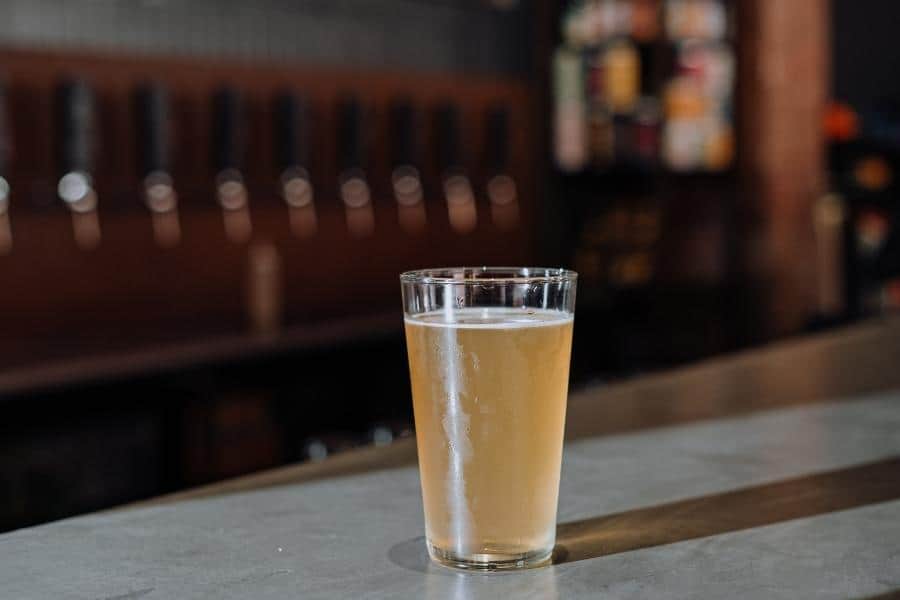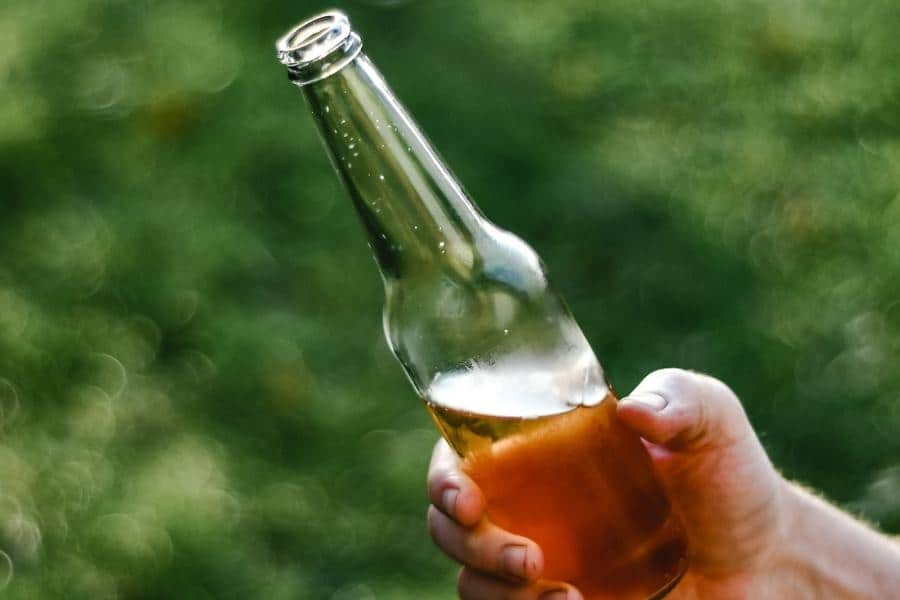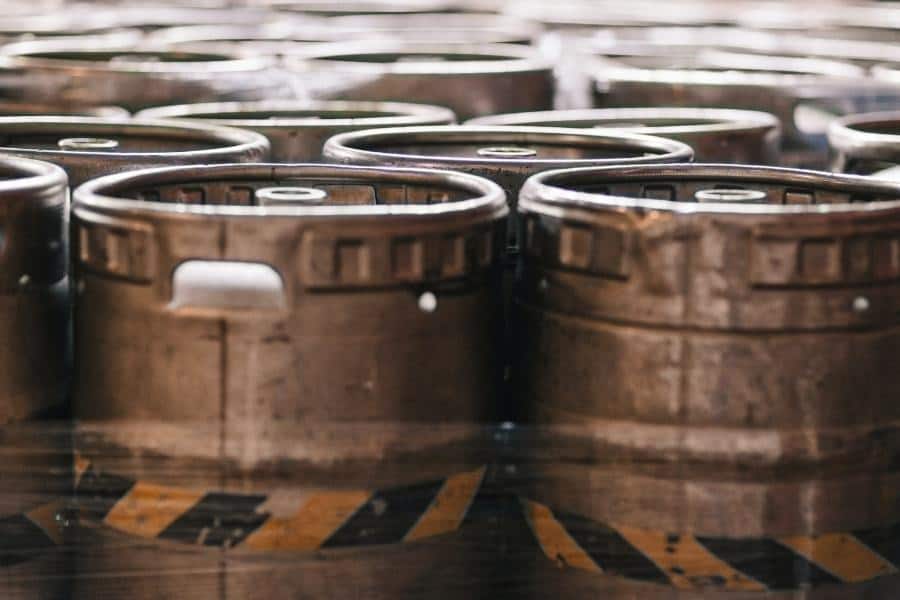If you buy something through a link in our posts, we may get a small share of the sale.
Gelatin is a common fining agent used in homebrewing and commercial brewing. It’s effective at clarifying beer and improving shelf stability. It’s derived from animal collagen and is available in powder or sheet form. Every brewer should know how to use gelatin in beer to produce the clearest, best-tasting beer.
Contents
How to Use Gelatin in Beer
Add 3/4 to 1 teaspoon of granulated gelatin per 5 gallons in distilled water. Ensure the gelatin is not flavored and does not contain any other ingredients. Let it dissolve in water for about 5-10 minutes. Next, heat the mixture to about 150–160 degrees Fahrenheit. Finally, cool the mixture and allow it to settle for about 24 to 48 hours before adding to the beer.

Many homebrewers add gelatin to their beer before packaging it. This is because gelatin has the ability to improve a beer’s stability and prevent it from going bad. Gelatin can also be added to kegs and casks. Ensure you purge these vessels with CO2 before adding the gelatin solution to prevent oxidation.
It’s best to add gelatin to your beer a few days before packaging or serving. This will allow the beer time to clear and any off-flavors caused by the gelatin to dissipate. Also, ensure your vessels are sanitized before adding the gelatin solution to prevent contamination.
How Does Gelatin Work?
Gelatin creates a thin barrier around yeast cells and other particulates, causing them to clump together and settle out of the beer. The gelatin molecules also attach to tannins and other haze-causing compounds, which are then removed from the beer.
The collective mass helps the particulates to settle out of the beer more quickly. The gelatin also absorbs oxygen, which can cause oxidation and staling. This is why it’s important to purge vessels with CO2 before adding the gelatin solution.
In most cases, gelatin works best by combining it with another fining agent, such as isinglass or Irish moss. The Irish moss helps coagulate the yeast cells, while the gelatin absorbs the tannins and other haze-causing compounds.
Step-By-Step Guide for Using Gelatin
Now that you have a basic understanding of how gelatin works and what it can do for your beer, let’s go over a step-by-step guide on how to use gelatin in beer. The following are easy steps for using gelatin to improve your beer’s clarity and shelf stability:
Assemble Your Materials
This is a process you can’t do without the proper materials. The advantage is that most of these materials are readily available, and you probably already have them in your kitchen. For this process, you’ll need:
- Gelatin – available in powder or sheet form for brewing
- Distilled water – to dissolve the gelatin and prevent contamination
- Measuring spoons – to measure the gelatin
- Pot – to heat the gelatin and water mixture
- Timer – to ensure you don’t overheat the mixture
- Carbon dioxide – to purge your vessels before adding the gelatin solution (optional)
- Thermometer – to ensure the mixture is not too hot (optional)
Sanitize Your Equipment
It’s important to sanitize all of your brewing equipment before using gelatin. This will prevent any bacteria or wild yeast from contaminating your beer. You can sanitize your equipment by using a no-rinse sanitizer.
You can also use a bleach solution, although you’ll need to rinse your equipment thoroughly with hot water afterward. Of importance is to avoid using any soaps, as these can leave behind residue that will affect the taste of your beer.
Make a Gelatin Solution
This is the first step in actually using gelatin in your beer. Here, ensure you have distilled or purified water, as tap water can contain chlorine, which will affect your beer taste. Boiling the water will also remove any chlorine present.

Add your gelatin (1/4 to 1 teaspoon per 5-gallon) to the distilled or purified water and let it sit for about five minutes. After five minutes, gently stir the mixture until the gelatin has completely dissolved.
Heat the Mixture
Next is to heat the gelatin solution. The ideal temperature is between 150 and 160 °F. Do not let the mixture boil, as this will degrade the gelatin’s clarifying power. At this stage, ensure you have a sanitized pot, whisk, and thermometer at hand.
Slowly heat the gelatin solution while whisking it gently. Once the desired temperature has been reached, remove the pot from the heat and allow it to cool.
Cool the Mixture
This is an important step, as you don’t want to add the gelatin solution to your beer while it’s still hot. This could potentially damage the yeast cells and affect your beer taste.
To cool the gelatin mixture, you can either place it in a cold water bath or the refrigerator. Once the mixture has cooled to room temperature, it’s ready to be added to your beer.
Add the Gelatin Solution to Your Beer
Ensure you have a sanitized funnel and strainer on hand. You’ll also need to aerate your beer before adding the gelatin solution, as this will help dissipate any off-flavors caused by the gelatin.
To aerate your beer, simply pour it back and forth between two vessels a few times. Once you’ve aerated the beer, add the gelatin solution and stir gently. After this, let the beer sit for at least 24 hours, so the gelatin has time to work its clarifying magic.
Package Your Beer
After 24 hours have elapsed, it’s time to package your beer. If you’re bottling your beer, ensure you have sanitized bottles and caps at hand. You’ll also need an auto-siphon and tubing to transfer the beer from the fermenter to the bottles.
When bottling, it’s important to avoid disturbing the sediment at the bottom of the fermenter. This sediment is known as trub and comprises yeast cells, protein, and hop debris.
If you’re kegging your beer, ensure you have a sanitized keg and CO2 tank on hand. The CO2 tank will be used to purge the oxygen from the keg before adding the beer. Once your beer is in the bottles or keg, store it in a cool, dark place for at least two weeks before serving.

Frequently Asked Questions
Can You Add Gelatin to Carbonated Beer?
Yes, you can add gelatin to carbonated beer. However, you’ll need to degas the beer first. This can be done by simply leaving the beer open to the air for 24 hours. The beer will go flat during this time. However, don’t worry about beer going flat, as it will re-carbonate once you add the gelatin solution.
Will Gelatin Remove Chill Haze?
Yes, gelatin can remove chill haze. Chill haze is caused by proteins and polyphenols present in the beer. Gelatin will cause these proteins and polyphenols to clump together and fall out of suspension, thus clarifying the beer.
Does Gelatin Affect Head Retention?
No, gelatin does not affect the head retention. In fact, gelatin can actually improve head retention in beer. This is because gelatin causes proteins to clump together, which creates a barrier that traps CO2 bubbles. This, in turn, results in a beer with a longer-lasting head.
What Is Isinglass Gelatin?
It is a purified form of gelatin that is commonly used in brewing. Isinglass gelatin is derived from fish, specifically sturgeon. It’s a popular choice among brewers because it clarifies beer effectively. However, some people may have ethical concerns about using fish products in their beer.
Conclusion
If you want to improve the clarity of your beer, gelatin is a great option. It’s easy to use and readily available. Plus, it won’t affect the taste of your beer. So, if you’re looking for a way to improve the appearance of your beer, give the gelatin a try.

